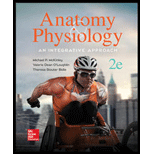
Concept explainers
All of the following general functions are carried out by all cells except
- a. obtaining nutrients and chemical building blocks.
- b. maintaining integrity of the plasma membrane.
- c. replacing cells through cell division.
- d. disposing of wastes.
Introduction:
The cell is a functional and structural unit of all living organisms and makes the basic building block of the body. Each type of cell performs specific functions such as disposal of the waste product, maintenance of shape and integrity of the cell, and obtaining nutrient from its surrounding fluids.
Answer to Problem 1DYKB
Correct answer:
The obtaining of the nutrients and chemical building blocks, maintaining the integrity of the plasma membrane, and disposing of waste, are the general functions performed by the cell. Therefore, option c. is correct.
Explanation of Solution
Reason for the correct statement:
Option c. is given as “replacing cells through cell division”. Some cells divide frequently such as epithelium cell of the intestine and an outer layer of skin, but most of the cells do not divide after maturation and specialization, such as muscle cells, nerve cells, and red blood cells. Hence, all the cells do not replace through cell division.
Hence, option c. is correct.
Reasons for incorrect statements:
Option a. is given as “obtaining nutrients and chemical building blocks”. Cells obtain their nutrients from the surrounding in order to complete metabolism and energy formation. Hence, option a. is incorrect.
Option b. is given as “maintaining the integrity of the plasma membrane”. Plasma membrane supports the cell in maintaining the framework and shape of the cell. Hence, option b. is incorrect.
Option d. is given as “disposing of waste”. Accumulation of waste products interfere with the normal functioning of the cell, and they are disposed of by the cell. Hence, option d. is incorrect.
Hence, options a., b., and d. are incorrect.
Cell replacement through cell division is not performed by adult and specialized cells.
Want to see more full solutions like this?
Chapter 4 Solutions
Anatomy & Physiology: An Integrative Approach
- please draw in what the steps are given. Thank you!arrow_forwardplease draw in and fill out the empty slots from image below. thank you!arrow_forwardThere is a species of eagle, which lives in a tropical forest in Brazil. The alula pattern of its wings is determined by a single autosomal gene with four alleles that exhibit an unknown hierarchy of dominance. Genetic testing shows that individuals 1-1, 11-4, 11-7, III-1, and III-4 are each homozygous. How many possible genotypes among checkered eagles in the population?arrow_forward
- students in a science class investiged the conditions under which corn seeds would germinate most successfully. BAsed on the results which of these factors appears most important for successful corn seed germination.arrow_forwardI want to write the given physician orders in the kardex formarrow_forwardAmino Acid Coclow TABle 3' Gly Phe Leu (G) (F) (L) 3- Val (V) Arg (R) Ser (S) Ala (A) Lys (K) CAG G Glu Asp (E) (D) Ser (S) CCCAGUCAGUCAGUCAG 0204 C U A G C Asn (N) G 4 A AGU C GU (5) AC C UGA A G5 C CUGACUGACUGACUGAC Thr (T) Met (M) lle £€ (1) U 4 G Tyr Σε (Y) U Cys (C) C A G Trp (W) 3' U C A Leu בוט His Pro (P) ££ (H) Gin (Q) Arg 흐름 (R) (L) Start Stop 8. Transcription and Translation Practice: (Video 10-1 and 10-2) A. Below is the sense strand of a DNA gene. Using the sense strand, create the antisense DNA strand and label the 5' and 3' ends. B. Use the antisense strand that you create in part A as a template to create the mRNA transcript of the gene and label the 5' and 3' ends. C. Translate the mRNA you produced in part B into the polypeptide sequence making sure to follow all the rules of translation. 5'-AGCATGACTAATAGTTGTTGAGCTGTC-3' (sense strand) 4arrow_forward
 Human Biology (MindTap Course List)BiologyISBN:9781305112100Author:Cecie Starr, Beverly McMillanPublisher:Cengage Learning
Human Biology (MindTap Course List)BiologyISBN:9781305112100Author:Cecie Starr, Beverly McMillanPublisher:Cengage Learning Human Physiology: From Cells to Systems (MindTap ...BiologyISBN:9781285866932Author:Lauralee SherwoodPublisher:Cengage Learning
Human Physiology: From Cells to Systems (MindTap ...BiologyISBN:9781285866932Author:Lauralee SherwoodPublisher:Cengage Learning





